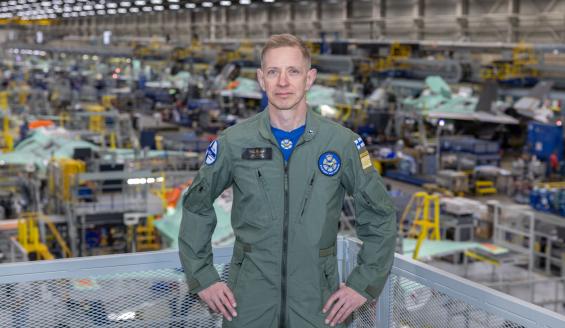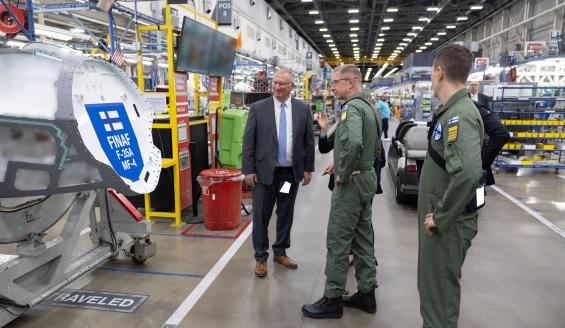The United States Prepares to Welcome the Finns

The Commander of the Finnish Air Force visited Lockheed Martin's F-35 production line in Fort Worth and the Ebbing Air National Guard Base in Fort Smith at the end of March. Finland's first F-35 fighter jets are currently in production, and preparations are underway at the training bases for the arrival of Finnish personnel.
The Commander of the Finnish Air Force, Major General Timo Herranen, and the F-35 Programme’s leadership visited at Lockheed Martin's F-35 production line in Fort Worth, Texas, on 20 March, and inspected the Ebbing Air National Guard Base in Fort Smith, Arkansas, on 24 March. During the visits, the status of Finland's F-35A multirole fighter production and the practical aspects of the F-35 initial training were updated.
Finland’s F-35A multirole fighters are currently in production
During his visit, the Commander of the Finnish Air Force met with Lockheed Martin leadership in Fort Worth, Texas, to discuss the status of Finland's F-35 production. He also observed the manufacturing stages of Finland's first F-35 fighters on the assembly line, which is Lockheed Martin's largest F-35 production line. The nearly one-and-a-half-kilometre-long line produces not only F-35A variants procured by Finland but also B- and C-variants.

The assembly line is surprisingly clean and quiet, with grey and turquoise-coloured F-35 components visible everywhere, along with various F-35 user countries’ aircraft at different stages of assembly. The turquoise colour of the components is due to a type of primer preparing them for stealth coating. Above one of the production stations, the Finnish flag is visible on a screen. The forward fuselage of the fourth Finnish F-35, JF-504, is being assembled there.

The type designation for Finnish F-35s is JF, derived from the term Joint Fighter, while the designation MF used internally at Lockheed Martin for the Finnish aircraft indicates that M was the next letter in the naming sequence and F was chosen to represent Finland.
Production of Finland’s first F-35A fighters began in late 2023. Last autumn, the progress of the Finnish aircraft production was celebrated with a signing ceremony of the JF-501’s forward fuselage.
It takes a total of 18 months to manufacture one F-35 fighter aircraft, starting from component production. F-35 components are assembled in several countries, with final assembly lines in Fort Worth, Cameri (Italy) and Nagoya (Japan). Once the components are completed, partner companies deliver the pieces to Lockheed Martin, and final assembly begins.

The F-35's airframe consists of the forward, center, and aft fuselages, as well as the wings. Final assembly begins with the assembly of the wing section. This is then mated with the aircraft’s major components. After final assembly, the aircraft is moved to the painting facility, where it receives its distinctive grey colouring in various shades. The aircraft’s design and coatings provide its stealth features. After painting, the aircraft undergoes system testing, including testing of its stealth capabilities, followed by test flights.
Upon successful completion of these tests, Lockheed Martin delivers the finished F-35 to the Defense Contract Management Agency (DCMA) of the U.S. Department of Defense, which acts as the recipient of the aircraft under the Foreign Military Sales (FMS) procedure and delivers it to the customer. Finland purchases its F-35 fighters through the FMS process.
The first eight aircraft for Finland will be delivered to Ebbing Air National Guard Base in Fort Smith, Arkansas. The tail numbers from JF-509 onwards will be delivered directly to Finland.
The aircraft currently produced on the F-35 production lines are the tangible result of decades-long development in the multinational F-35 Program, which continues even after the aircraft are produced. F-35 user countries, meaning nations operating the aircraft or countries that have signed a procurement contract, presently total 20, of which 13 are from Europe, including Finland. Over 1,150 F-35s have been delivered to partner and customer nations, and the aircraft have accumulated over a million flight hours.
Simulator flying precedes the initial training
During his visit to Lockheed Martin, Major General Herranen also participated in a simulator training event for Finnish Air Force pilots preparing for F-35 initial training in the U.S. The Manned Tactical Simulator (MTS) event using F-35 simulators has been held three times in Fort Worth for Finnish pilots. The pilots trained on the simulators to familiarise themselves with the aircraft’s systems, cockpit procedures, and formation tactics in various, often quite challenging, joint operations.
Finnish pilots heading to the U.S. for F-35 initial training report that the simulator exercises have provided them with a solid foundation for their upcoming training. According to U.S. Air Force air combat instructors, Finnish pilots have demonstrated excellent baseline skills and fast learning speeds.

Finland will acquire at least two types of F-35 simulators: the Full Mission Simulator (FMS) and FENIX (F-35 Emulated Non-OFP Interoperability Experience). The FENIX simulator is already in use at the Air Combat Centre at Satakunta Air Wing in Pirkkala. The FMS simulator provides the highest level of realistic training, with the simulator cockpit nearly identical to that of the actual F-35. The FENIX system is a simpler simulator used for training interoperability with other services and allies.
Ebbing Air National Guard Base and the city of Fort Smith extend a warm welcome to the Finns
During his visit to the United States, the Commander of the Finnish Air Force inspected the Ebbing Air National Guard Base in Fort Smith, Arkansas. Ebbing ANGB is another of the U.S. bases where Finland's F-35 initial training will take place. After completing theoretical and simulator training at Eglin Air Force Base in Valparaiso, Florida, the Air Force pilots, maintenance personnel, and other specialists will transfer to Ebbing for practical training.

The visit to Ebbing Air National Guard Base was hosted by Major General Gregory Kreuder, Commander of the 19th Air Force. In addition to Finnish Air Force participants, those present included Major General Ricky Mills, Assistant Deputy Under Secretary of the Air Force, International Affairs; Brigadier General Bradley Cox, Deputy Adjutant General, Arkansas National Guard; and representatives from organizations such as Air Education and Training Command (AETC), Joint Program Office (JPO), 33rd Fighter Wing, Air Force Security Assistance Training Squadron (AFSAT), 57th Fighter Squadron, 33rd Fighter Wing, Air Force Civil Engineer Center (AFCEC) and Lockheed Martin. The visit also included representatives from the city of Fort Smith and from the offices of senators and congress members representing Arkansas in the U.S. Congress.
During the on-site visit, the Commander of the Finnish Air Force discussed the practical aspects of the Finnish F-35 initial training to be conducted at Ebbing ANGB with representatives of the U.S. Air Force and National Guard.

During his visit to Ebbing ANGB, the Commander of the Finnish Air Force inspected the training facilities and areas where Finnish personnel will work during their F-35 initial training. The base’s infrastructure is currently undergoing significant development.

One of the Finnish Air Force's future flight instructors, Lieutenant Colonel Jonathan 'Rev' Hassell, Commander of the 57th Fighter Squadron, mentioned that the 57th Fighter Squadron at Ebbing is already looking forward to the arrival of Finnish personnel for F-35 initial training.
– We will train Finnish pilots using the same methods and to the same standards as US pilots, says Lieutenant Colonel Jonathan “Rev” Hassell.

Currently, personnel from the Polish Air Force are undergoing F-35 training at Ebbing ANGB. In addition to the Finnish personnel, the base is also training Air Force personnel from other F-35 user countries, including Germany, Switzerland, and Singapore.
During the on-site visit to Ebbing ANBG, the Finnish Air Force delegation was also introduced to the Razorback Range training and firing area located near the base. The advantage of Razorback Range is its short distance from the base, which the Finnish personnel found particularly convenient, being accustomed to short distances between the base and training areas at home.

The Commander of the Finnish Air Force saw the city of Fort Smith as hospitable and in anticipation of the Finnish group's arrival.
– The reception from the city of Fort Smith and the Chamber of Commerce towards the Air Force was warm and reassuring. Mayor George McGill had mobilised his team extensively to support us, and everything conveyed a sense of anticipation for the arrival of the Finnish personnel to the city, Major General Herranen says.

The Finnish Defence Forces study the F-35 system in advance
Knowledge and understanding related to the F-35 system is being acquired proactively within the Finnish Defence Forces. Various seminars and training events are preparing FDF personnel for the operation of the F-35 system, ensuring that by the time the first aircraft arrive in Finland, the necessary know-how and expertise will already be in place.

Photo: Lockheed Martin / Kyle Larson
One example of F-35 training is the first phase of the Engineering Seminars training series, which started in April at the Defence Forces Logistics Command’s Joint System Centre in Aitovuori, Tampere. The aim of this phase is to provide participants with a basic understanding of the F-35 system's operation and to introduce the fighter aircraft from various perspectives. In this training programme, Lockheed Martin will go through the F-35’s systems, armament, and airframe with key personnel from the Finnish Defence Forces and the national defence industry. The training enhances FDF personnel’s preparedness in areas such as aircraft type certification, acceptance and airworthiness inspections, as well as continuous airworthiness management.
Within the branches of the FDF, F-35 knowledge is shared through various events. In January, the Air Force organised a training event at Satakunta Air Wing, where U.S. F-35 pilots shared information about the fighter’s capabilities and operations with representatives from the Air Force, Army, and Navy. In early April, a Multi Domain Operations (MDO) war game event was held at the Air Combat Centre. During the event, various scenarios were played out, where the F-35 multirole fighter was operated in conjunction with the Army and Navy’s capabilities.
In addition, the Finnish Air Force regularly practices F-35 interoperability. Currently, the Ramstein Flag 25 exercise is taking place in the Netherlands, where the Air Force F/A-18 Hornet fighters are training alongside the Royal Netherlands Air Force F-35 fighters.


Close and steady coordination on the implementation of the F-35 Programme continues
The timeline for the introduction of Finland's F-35 capability is tight. The execution of F-35 initial training requires continuous planning and coordination from both the Air Force personnel and their American counterparts.
During his visit to Lockheed Martin and Ebbing ANGB, Major General Herranen emphasised the priorities of the Air Force.
– When the Finns start at Ebbing, the F-35 training operations at the base are in the early stages, and increasing the training volume will take time. In the discussions at Ebbing, the words and commitment from the U.S. military conveyed a strong dedication to ensuring that the Finnish F-35 initial training will be carried out in such a way that the introduction of Finland’s F-35 capabilities proceeds as planned, Herranen summarizes.

Photo: 33rd Fighter Wing / Senior Airman Christian Corley
The Air Force is set to begin training on the F-35 system in Finland in the latter half of 2026, as soon as the Air Force has received the first aircraft in Finland. At that time, pilots, maintenance personnel, and other specialists who have completed the initial F-35 training will begin training FDF personnel on the operation of the F-35 system.




